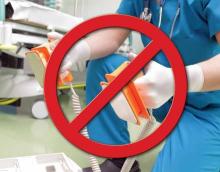FDA approves first naloxone nasal spray for opioid overdose
BY DEEPAK CHITNIS
Frontline Medical News
The US Food and Drug Administration (FDA) has approved the first nasal spray variant of the opioid-overdose drug naloxone hydrochloride.
Marketed in the United States as Narcan (Adapt Pharma, a partner of Lightlake Therapeutics, Radnor, Pennsylvania) the nasal spray is known to stop or, in some cases, reverse the effects of opioid overdosing in patients. Narcan is the first naloxone hydrochloride nasal spray approved by the FDA.
“Combating the opioid abuse epidemic is a top priority for the FDA,” Dr Stephen Ostroff, FDA acting commissioner, said in a statement released with the November 18 approval announcement. “While naloxone will not solve the underlying problems of the opioid epidemic, we are speeding to review new formulations that will ultimately save lives that might otherwise be lost to drug addiction and overdose.”1
The nasal spray itself is available only with a prescription, and is safe for use by both adults and children, according to the FDA.
The spray delivers a dose of 4 mg naloxone in a single 0.1-mL nasal spray, which comes in a ready-to-use, needle-free device, according to Adapt Pharma. Administration of Narcan, which is sprayed into one nostril while the patient is lying on his or her back, does not require special training.
The FDA warned that body aches, diarrhea, tachycardia, fever, piloerection, nausea, nervousness, abdominal cramps, weakness, and increased blood pressure, among other conditions, are all possible side effects of Narcan.
Narcan’s approval is one step of many that must be taken to adequately address and ultimately end the problem of opioid abuse in the US, cautioned Dr Peter Friedmann, an addiction medicine specialist and chief research officer at Baystate Health in Springfield, Massachusetts. He expressed concern regarding the pricing of Narcan, noting that the drug’s affordability is crucial to its success.
“Right now, nasal atomizers with syringes are used off label, and the prices have been going up with increasing demand,” he said. “But [Narcan] is a commercial product based around what is essentially a generic medication, so [I] hope it’s priced at a price point that’s accessible to the great majority of patients and their families who are facing addiction, many of whom don’t have huge means.”
Therapeutic hypothermia after nonshockable-rhythm cardiac arrest
BY MARY ANN MOON
FROM CIRCULATION
Vitals Key clinical point: Therapeutic hypothermia raises the rate of survival with a good neurologic outcome in comatose patients after a cardiac arrest with a nonshockable initial rhythm. Major finding: The rate of survival-to-hospital discharge was significantly higher with therapeutic hypothermia (29%) than without it (15%), as was the rate of survival with a favorable neurologic outcome (21% vs 10%). Data source: A retrospective cohort study involving 519 adults enrolled in a therapeutic hypothermia registry during a 3-year period. Disclosures: This study was supported by the National Institutes of Health. Dr Perman and her associates reported having no financial disclosures. |
Therapeutic hypothermia significantly raises the rate of survival with a good neurologic outcome among patients who are comatose after a cardiac arrest with a nonshockable initial rhythm, according to a report published online November 16 in Circulation.1
Many observational and retrospective cohort studies have examined the possible benefits of therapeutic hypothermia in this patient population, but they have produced conflicting results. No prospective randomized clinical trials have been published, and some clinicians insist the treatment should be reserved for patients who meet the narrow criteria for which there is good supportive evidence; others, eager for any clinical strategy that can improve the outcomes of these critically ill patients, routinely expand its use to comatose patients regardless of their initial heart rhythm or the location of the cardiac arrest, wrote Dr Sarah M. Perman of the department of emergency medicine, University of Colorado, Aurora, and her associates.
They studied the issue using data from a national registry of patients treated at 16 medical centers that sometimes use therapeutic hypothermia after cardiac arrest. They assessed the records of 519 adults who had a nontraumatic cardiac arrest and initially registered either pulseless electrical activity or asystole, then had a return of spontaneous circulation but remained comatose. Approximately half of these comatose survivors (262 patients) were treated with therapeutic hypothermia according to their hospital’s usual protocols, and the other half (257 control subjects) received standard care without therapeutic hypothermia.
Patients who received the intervention were significantly younger (62 vs 69 years), had a longer duration of cardiac arrest (23 vs 13 minutes), had a higher incidence of asystole as their primary cardiac rhythm (45% vs 35%), and were much more likely to have an out-of-hospital cardiac arrest (82% vs 39%). To account for these marked differences and to control for confounding by indication, the investigators used propensity matching and identified 200 matched pairs of patients.
